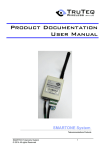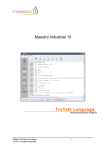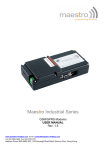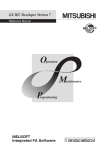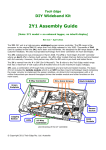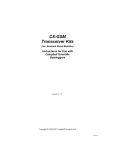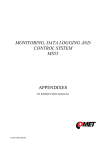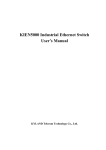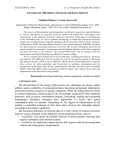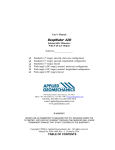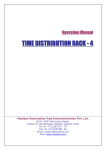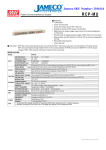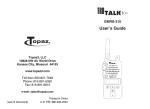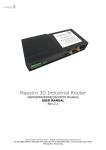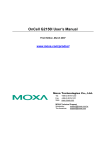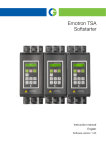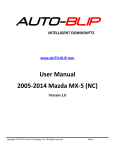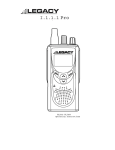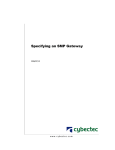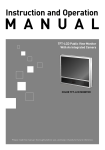Download Maestro Industrial 10
Transcript
Product Documentation User Manual Maestro Industrial 10 Industrial M2M Gateway Maestro Wireless Solutions © 2010 All rights Reserved 1 TABLE OF CONTENTS 1 INTRODUCTION ..................................................................................................................4 1.1 Background ..................................................................................................... 4 1.2 What’s new ...................................................................................................... 4 1.2.1 Connection comparisons..........................................................................................4 1.3 System Description ......................................................................................... 5 1.4 Digital vs. Analogue......................................................................................... 6 1.5 Status LEDs .................................................................................................... 6 1.6 The Ultimate in Stability – Comm Alive! ......................................................... 7 2 EVENTS ...............................................................................................................................7 2.1 Digital Input events .......................................................................................... 7 2.2 Timer events.................................................................................................... 7 2.3 Counter events ................................................................................................ 7 2.4 Serial events.................................................................................................... 7 2.5 Analogue events.............................................................................................. 8 3 MI-10 START-UP..................................................................................................................9 4 COMMAND MODE .............................................................................................................10 4.1 Entering Commands...................................................................................... 10 5 MI-10 ELECTRICAL INTERFACES....................................................................................11 5.1 AC Mains Supply ........................................................................................... 11 5.2 DC Supply ..................................................................................................... 12 5.3 Digital Outputs ............................................................................................... 13 5.4 Digital Inputs.................................................................................................. 14 5.5 Analogue Inputs ............................................................................................ 15 5.6 RS485 Data port............................................................................................ 16 5.7 RS232 Data port............................................................................................ 17 5.7.1 PC serial cable pin-out ...........................................................................................17 5.7.2 DB25 serial cable pin-out (for Elster meters) ........................................................18 5.7.3 RJ12 serial cable pin-out (for Landis&Gyr meters) ................................................18 5.8 Audio port ...................................................................................................... 19 5.9 SIM card slots................................................................................................ 19 5.10 SD card slot ................................................................................................. 19 5.11 Expansion Port ............................................................................................ 20 6 ELECTRICAL SPECIFICATIONS.......................................................................................20 7 OTHER SPECIFICATIONS ................................................................................................20 8 SERVICING THE MI-10......................................................................................................21 9 DISCLAIMER ......................................................................................................................24 10 GLOSSARY ......................................................................................................................24 11 REVISION INFORMATION ..............................................................................................24 12 WARNINGS ......................................................................................................................25 13 CONTACTING MAESTRO WIRELESS SOLUTIONS ......................................................25 14 NOTICES & TRADEMARKS ............................................................................................25 Maestro Wireless Solutions © 2010 All rights Reserved 2 1 INTRODUCTION 1.1 Background The Maestro Industrial 10 is a versatile industrial RTU (Remote Terminal Unit) with integral modem for communications to IEDs (Intelligent Electronic Devices). It was primarily developed as an AMR (Automated Meter Reading) modem, but has since then found a whole range of applications in the telemetry, SCADA, security, farming, home and office automation industries. 1.2 What’s new The MI-10 is an upgrade from the previous model with the following new features: • Standard IO, RS232 and RS485 on all models (no more Options - but all in one) • Casing with more status LEDs • External DC input connections • 2 added Digital outputs • 2 added Analog inputs • Audio interface • Expansion port to add more I/O • Dual SIM card feature • Data logging card slot 1.2.1 Connection comparisons Maestro Wireless Solutions © 2010 All rights Reserved 3 1.3 System Description The MI-10 is a GSM/GPRS terminal intended to be used in industrial telemetry applications. Even though the MI-10 can act like a GSM modem, it offers much more in terms of communications, inputs, and event-based programming. By using simple commands, the MI-10 can switch between using CSD (circuit switched data) calls, or GPRS to communicate with a device on the serial port. Four fully programmable inputs, timers, counters and other events provide a very powerful and future-proof solution for industrial communications. More input/output expansion units can be added (if required) to increase the total number of digital inputs and outputs and/or analogue inputs and outputs, to a maximum of seven units. The following expansion units are available: • 4X4 I/O – 4X Isolated inputs (digital or analog) and 4X 5A 250Vac relay contact outputs • 8X smart Input – These 8 inputs can be configured either as pulse counter inputs or normal digital inputs • 8X smart Outputs – These 8 outputs can either be 8 internal 5A 250V relays or 8X 100A external relays The following expansion units will be available in near future: • 4X Camera – 4X Camera inputs for capturing photos and video clips per request • 3 Phase Energy meter – An expansion to connect 3 phase electricity to measure volts, current, power factor and line quality parameters The MI-10 executes the scripted Commands that are linked to all the triggered events, as well as scripted Commands received via SMS / CSD call or GPRS connection. A triggered event can be, for instance, an input going from high to low or the timer that runs out. Commands can, for instance, send SMS, report status to a server, toggle an output or clear a timer. Events Event A Event B Command Lists Script linked to event A <Command> <Command> <Command> <Command>; Script linked to event B <Command> <Command> <Command> <Command> <Command>; Event C Script linked to event C Script contained in SMS <Command>; <Command> <Command>; SMS messages sent to the MI-10 are executed as a script. Maestro Wireless Solutions © 2010 All rights Reserved 4 1.4 Digital vs. Analogue Unless specified otherwise, all inputs and outputs referred to in this manual are Digital inputs and Digital Outputs 1.5 Status LEDs A display of 20 LEDs offers a powerful troubleshooting and verification function: Modem specific (top line): LED Meaning Power Power present GSM Network GSM Network state TX RX DTR DSR RTS CTS RI DCD Transmit Receive Data Terminal Ready Data Set Ready Request to Send Clear to send Ring Indicator Data Carrier Detect States Off : Not powered On : Powered On solid : Searching Short Flash : Logged on network Long Flash : Busy in data call On : Modem transmits data On : Modem receives data On : IDE ready On : Modem ready On : Meter ready to transmit data On : Modem ready to accept data Flash : Ring - waiting to answer On : Busy in data call or GPRS session Additional indications (bottom line): LED Meaning Signal Received Signal Strength SIM SIM card selection Info Activity Information Heart Heart beat 232 485 RS232 RS485 Maestro Wireless Solutions © 2010 All rights Reserved States 1 LED on: Low signal 2 LEDs on: Medium signal 3 LEDs on: Good signal 4 LEDs on: Very good signal 1 : SIM card slot 1 selected 2 : SIM card slot 2 selected Initialisation : Blink rapidly every 2 seconds Data connection open : On and blink off rapidly SMS RX : Blink rapidly while sms is received SMS TX: Blink slowly while sms is send GSM mode Idle : Single short blips GPRS mode Idle : Double short blips On : Activity on RS232 port On : Activity on RS485 port 5 1.6 The Ultimate in Stability – Comm Alive! Telemetry users know that their devices are often in remote or inaccessible areas. The last thing they can afford is to have to continuously visit a number sites to reset these devices. There are four major causes of failures in GSM-based telemetry : 1. Lock-ups between modem and GSM network. 2. Not terminated data calls. 3. Loss of network authentication. 4. Unknown network or modem status. By using proven and patented technology, the MI-10 is kept as stable as possible. Depending on the customer’s preferences on order, the modem will reset under any of the following conditions : 1. Every 24 hours (only if not in data call). 2. If a data call is unterminated for longer than 45 minutes. 3. If the modem loses GSM network authentication for longer than 10 minutes. If the modem is in a data call when the 24hr reset cycle starts, the modem will wait for 10 minutes before resetting. The default reset options are : 1. Every 24 hours (only if not in data call). 2. If the modem loses GSM network registration for longer than 10 minutes. 2 EVENTS An event is a change in condition and where certain commands then needs to be executed. 2.1 Digital Input events Separate Command Lists are linked to the events where an input goes high (on/open) or low (off/closed). The delay times (also known as the “debounce” times) before the unit registers a change in input state can be configured. More input/output expansion units can be added to increase the total number of inputs and outputs. 2.2 Timer events Separate Command Lists are linked to the events where a timer runs out. There are 10 separate timers. 2.3 Counter events Separate Command Lists are linked to the events where a counter reaches one of it’s low or high levels. There are 10 different counters, each with it’s own high and low levels. 2.4 Serial events The MI-10 can be configured to execute certain commands when data is received on the serial port. Typical applications are tag readers and bar-code scanners as well as a whole list of devices that sends out unsolicited serial data. Maestro Wireless Solutions © 2010 All rights Reserved 6 2.5 Analogue events Separate Command Lists are linked to the events where an analogue value passes a certain level. The following diagram explains which command lists are associated with which level. Maestro Wireless Solutions © 2010 All rights Reserved 7 3 MI-10 START-UP The MI-10 will print ‘BOOT’ information on start-up. This information is printed on the serial port at the last baud rate and framing that the MI-10 was set to with command 257. Please see description of command 257 in the TruTalk manual. The first line will always print the hardware configuration with <DigIn>X<DigOut>X<AnIn>. The second line will always print the current firmware version. The third prints the serial number ext. The MI-10 is ready for operation once the “Start-up complete!!” sentence is printed. One can now enter commands via command mode (AT$TT) or use it as a standard modem. Maestro Wireless Solutions © 2010 All rights Reserved 8 4 COMMAND MODE By default the MI-10 serial port acts as a standard modem. However this serial port is also used to enter commands and to configure the MI-10. The AT command AT$TT is used to enter the standard TruTeq Text mode command prompt. In this mode the MI-10 will echo all incoming text, and add command prompts and readable carriage returns as well as line feeds. The command mode will timeout after a default 30 seconds, or can be quitted by typing <ctrl-z>, this will return the MI-10 into normal modem mode. A simplified command mode is also available for use with serial applications by entering AT$RT (RawText). In this mode there will be no echoing or prompts to simplify the serial encapsulation in a typical application. 4.1 Entering Commands Commands can be entered once the MI-10 is in command mode. ! Default serial parameters are: 9600,8,N,1. ! A List of all the commands and descriptions are available in the document: “TruTalk” Maestro Wireless Solutions © 2010 All rights Reserved 9 5 MI-10 ELECTRICAL INTERFACES 5.1 AC Mains Supply The MI-10 may be powered from 90VAC to 265VAC. The mains supply is connected to the terminal block as shown in the following picture : Important Notices Even though the MI-10 Industrial will operate without an earth connection, this should always be connected for safety reasons. Ensure that the supply wires are inserted and fixed in the correct terminals. Always use SABS approved mains cables. Do not used frayed cables. Please take care when connecting the mains supply, as the possibility of an electric shock exists if the installer inadvertently touches the live or neutral wires or connects the supply to the wrong terminals. Always take all relevant safety precautions. If you are unsure about this – please contact a qualified person to connect and secure the mains connections Maestro Wireless Solutions © 2010 All rights Reserved 10 5.2 DC Supply An optional Low voltage DC Supply (8Vdc -> 30Vdc) input allows the integrator to configure the MI-10 in such a way that a backup battery or DC PSU can keep the modem alive after loss of mains supply. Typical connection diagram: Important Notices Observe polarity on the DC input! Do not connect mains AC and external DC simultaneously! Note that the Low voltage DC supply must be capable of supplying at least 12VA. This means that, at 12V, the supply must be able to supply 1A. This is not the continuous current that the MI10 requires, but the pulses required when the modem is in communication during a download. Maestro Wireless Solutions © 2010 All rights Reserved 11 5.3 Digital Outputs The MI-10 digital outputs are potential free relay contacts. Relay 1 (output1) is between pin 1 and 1 Relay 2 (output2) is between pin 2 and 2 The relay’s contacts have the following rating: 30Vdc 1A The following figure illustrates how the outputs can be connected in a typical application. Maestro Wireless Solutions © 2010 All rights Reserved 12 5.4 Digital Inputs The digital inputs are potential free inputs. A connection must be made between the common (pin C) and the corresponding digital input, either with a switch, or a relay contact. Typical connection diagram: ! Note: The inputs are NOT opto-isolated. ! Note: Do NOT apply any voltage on either the common or the individual inputs Maestro Wireless Solutions © 2010 All rights Reserved 13 5.5 Analogue Inputs The analogue inputs can be configured for the following input types: 1) 0-5V (default setting) 2) 0-30V 3) 0-20mA Internal jumper settings as per options above: Option1 (0-5V) ! ! Option2 (0-30V) Option3 (0-20mA) Note: The inputs are NOT opto-isolated. Note: The inputs do not need to be set to the same option thus input1 can be 0-5V and input2 can be set to 0-20mA Typical analogue connection diagram 1: • Analogue input1 monitors the 12V back-up • Analogue input2 monitors a level sensor with current source output Typical analogue connection diagram 2: • Analogue input1 monitors a 2 wire sensor (current sink e.g. Truteq temperature probe) • Analogue input2 monitors a RPM sensor with voltage output Maestro Wireless Solutions © 2010 All rights Reserved 14 5.6 RS485 Data port The MI-10 comes standard with a secondary RS485 port. If the port has been enabled (with command !254 1) then the MI-10 will change over from the RS232 port to the RS485 port once startup was completed successfully. ! Note: An easy way to return to the RS232 port is to start-up the modem with no SIM card inserted. Once start-up is complete then the modem will stay in RS232 mode and command !254 0 can be issued. Maestro Wireless Solutions © 2010 All rights Reserved 15 5.7 RS232 Data port The RS232 port is the MI-10's primary data port. It is an RJ45 socket with the following pin-out: Pin number Description 5.7.1 Direction 1 DCD Out 2 RX data Out 3 TX data In 4 DTR In 5 GND - 6 RTS In 7 CTS Out 8 RI Out PC serial cable pin-out Maestro Wireless Solutions © 2010 All rights Reserved 16 5.7.2 DB25 serial cable pin-out (for Elster meters) 5.7.3 RJ12 serial cable pin-out (for Landis&Gyr meters) Maestro Wireless Solutions © 2010 All rights Reserved 17 5.8 Audio port The Audio port is an RJ12.6 socket with the following pin-out: Pin number Description Direction 1 +12V Out 2 MIC+ In 3 SPKR+ Out 4 SPKR- Out 5 MIC- In 6 GND - The Power between pins 1 and 6 can be used to drive an external audio amplifier. An RJ11.4 connector from a POTS handset can also be plugged in between pins 2 to 5. 5.9 SIM card slots The MI-10 is fitted with 2 SIM card push-push slots. Make sure not to insert the SIM card above or below the required slot as you might then need to open up the MI-10 to retrieve your SIM card. ! Note: See command !60 in the TruTalk manual for SIM selection options 5.10 SD card slot The MI-10 is fitted with a micro SD card push-push slot. Add up to a 4GB card to utilize the logging features. ! Note: See commands !97 and !98 for logging features Maestro Wireless Solutions © 2010 All rights Reserved 18 5.11 Expansion Port The MI-10 is fitted with an EXP port connector. This is used to connect to expansion input and output units. ! Note: Refer to the individual expansion unit's manuals for their features and operational commands and specifications 6 ELECTRICAL SPECIFICATIONS Power supply : Input Mains (AC) Mains (DC) Low voltage DC Min 85VAC 110VDC 8VDC Antenna Connector Type Gender Impedance Max 264VAC 370VDC 30VDC Max Power 10W 10W 10W Input Protection 3 X MOV + 2A Fuse 3 X MOV + 2A Fuse Tranzorb + Poly switch SMA Female 50! 7 OTHER SPECIFICATIONS 7.1 Physical Size Weight Casing material Temperature rating Humidity 80mm x 170mm x 35mm 725g Metal alloy -20°C to 60°C Up to 90% RH non-condensing 7.2 Manufacturer’s Type Number The type number for the Maestro Industrial 10 is MI-10. Maestro Wireless Solutions © 2010 All rights Reserved 19 8 SERVICING THE MI-10 8.1 Powering up the MI-10 8.1.1 Using Mains Supply 1. Switch off or disconnect mains supply 2. Insert SIM card 3. Connect data or auxiliary ports 4. Connect mains power to MI-10 5. Reconnect mains supply 8.1.2 Using DC Supply 1. If connected to a DC supply, switch the supply off or disconnect the DC cable 2. Insert SIM card 3. Connect data or telemetry ports 4. Connect or power up DC supply 8.2 Configuring the Device All commands are typed in the terminal window of an application such as Windows HyperTerminal or preferably with Maestro Wireless Solutions SmartTerminal. Start off with a test to see if the communications settings are the same between the modem and the terminal window. If these settings are not the same, you will not be able to communicate properly. Type in “AT” and ENTER The modem should respond with “OK”. If it does not respond with “OK”, then there is a problem. Refer to the Trouble Shooting section further in the document. It is important that communication with the modem is established before continuing. Close the COM port (some terminal programs may call this “disconnect”) and change the communication speed of the software to 9600 baud. This is necessary in order to be able to talk to the modem, which will now be set to 9600 baud. Open the COM port again. Check if a PIN number is required for the SIM card Type in the command: AT+CPIN? If the response is : +CPIN: READY carry on to the next section If the response was : +CPIN: SIM PIN the Modem requires a PIN number first. Issue the PIN number as follows : AT+CPIN=00000 For the default PIN number of 00000. If the PIN number is different, use the number you received with the SIM card. You should now get the response : OK Maestro Wireless Solutions © 2010 All rights Reserved 20 Disable the PIN with the following command : AT+CLCK=”SC”,0,00000 Where the 00000 is the default PIN number. Use the supplied PIN number if different from 00000. The response should be : OK Important : If you type in the wrong PIN number three times, you will have to unblock the card using the PUK number. The easiest way is to use your cell phone to unblock the SIM. Check if the modem is registered on the GSM network Type in the command: AT+CREG? If the response is : +CREG: 0,1 carry on to the next section Other possible responses could be : +CREG: 0,0 – Searching for any network +CREG: 0,2 – Network found, busy registering +CREG: 0,5 – Registered on a roaming network If the response is 0,0 or 0,2, then wait a while for the modem to register. Try the command again until registered. If the 0,5 response was received, then the modem is registered on a foreign GSM network. This could happen close to international border. There may be substantial financial implications if communication takes place through a foreign network, even if the modem only receives the calls. Check the signal strength Type in the command: AT+CSQ The response should be at least +CSQ: 10,0 the 10 indicates signal strength and this result value should be better than 10. The 0 result value is an indication of the bit error rate on the radio interface, and should be a value from 0 to 7. If this value is 99, it means that the modem has not been able to resolve the error rate. The modem performs automatic error correction on the radio interface, so the bit error rate is not a critical value and can be ignored. The important result value is the signal strength. Set the automatic answer Type in the command: ATSO=2 The response should be : OK Set the incoming bearer type Type in the command: AT+CICB=0 The response should be : OK Save the settings Type in the command: AT&W The response should be Maestro Wireless Solutions © 2010 All rights Reserved 21 OK 8.3 Troubleshooting 8.3.1 No LEDs come on Test the supply with an appropriate meter. The values should be within the input voltage ranges. If the measured voltages are all within range, the modem may be faulty. 8.3.2 Power LED, and CTS LED come on, but the GSM LED won’t flash If the GSM LED does not start flashing after 10 or 20 seconds, the modem cannot register. This could mean that the GSM coverage is not adequate (try better antenna positions), that there is a PIN number required for the SIM card (remove it using the method described), or that the SIM card is blocked by the GSM network, or even faulty (replace the SIM card). 8.3.3 I get an “OK” for an AT<enter> request, but I can’t program the modem. You may be in communication with another modem inside your computer. A normal fixed line modem will respond almost the same a the MI-10, but will give errors when certain (GSM specific) commands are given to it e.g. AT+CSQ Try looking for the GSM device on another COM port. 8.3.4 Calls are frequently dropped This is usually due to either a poor signal strength, or to a backup supply with insufficient driving capacity when running from backup DC supply. To test, check the signal strength as follows : Type in the command: AT+CSQ The response should be at least : +CSQ: 10,0 the 10 indicates signal strength and this result value should be better than 10. The 0 result value is an indication of the bit error rate on the radio interface, and should be a value from 0 to 7. If this value is 99, it means that the modem has not been able to resolve the error rate. If the signal strength is lower than 10, try relocating the antenna to a higher position. If you are using a magnetic mounting antenna, try mounting the antenna on a metal plate. A high gain antenna like a yagi may also solve the problem. If the MI-10 is running from a DC Backup supply and signal strength is high, check the supply capacity to be greater than 1A 12V (>12VA) Maestro Wireless Solutions © 2010 All rights Reserved 22 9 DISCLAIMER Maestro Wireless Solutions does not accept any direct or indirect liability for the use of any Maestro product. The customer takes full responsibility for its use and any liability or damage that may arise from the use of the Maestro Wireless Solutions product. NOTE: This product is not designed or certified for use as medical equipment or with medical equipment or with medical devices. This product is also not designed or certified to be used with any medical services or medical related services. 10 GLOSSARY Abbreviation API ASN.1 CDR CSV DB DNS FQDN GAIN HTTP HTTPS IVR I/O IP MMS MMSC PDA SMSC SMPP USSD WIG WAP WML WASP XML Description Application programmers Interface Abstract Syntax Notation One Charge Data Record Comma Separated Values Database Domain Name System Fully Qualified Domain Name Gateway Application and Interface Node Hypertext Transfer Protocol HTTP Secure Interactive Voice Response Input/Output Internet Protocol Multimedia Message Service Multimedia Messaging Service Centre Personal Digital Assistant Short Message Service Centre Short Message Peer to Peer Protocol Unstructured Supplementary Services Data Wireless Internet Gateway Wireless Application Protocol Wireless Mark-up Language Wireless Application Service Provider Extensible Markup Language 11 REVISION INFORMATION Date 09 November 2010 Version 1.0 Maestro Wireless Solutions © 2010 All rights Reserved Comments Author Eric Guldemond Create document 23 12 WARNINGS WARNING: Do not open this equipment under any circumstances. High risk of electrical shock exists that may and probably will lead to injuries and/or death. 13 CONTACTING MAESTRO WIRELESS SOLUTIONS Telephone Fax Web email +852 2869 0688 +852 2525 4701 www.maestro-wireless.com [email protected] Maestro Wireless Solutions Ltd 3603-09, 36/F., 118 Connaught Road West Hong Kong HONG KONG 14 NOTICES & TRADEMARKS Copyright Notice Copyright © 2010 Maestro Wireless Solutions LTD. All rights reserved. No part of this document may be reproduced in any form or by any means without prior written authorization from Maestro Wireless Solutions LTD Trademarks Maestro Wireless Solutions and the Maestro corporate logo are trademarks of Maestro Wireless Solutions. All other trademarks appearing in this guide are the exclusive property of their respective owners. General Notice Maestro Wireless Solutions reserves the right to revise this document without obligation to provide notification of such changes. Maestro Wireless Solutions provides this documentation without warranty expressed, implied, statutory, or otherwise, and specifically disclaims any warranty of merchantability or fitness for a particular purpose. Maestro Wireless Solutions may make improvements or changes in the product(s) and/or the program(s) described in this documentation at any time. Maestro Wireless Solutions assumes no responsibility for product reliability and/or performance if any party other than Maestro Wireless Solutions modifies the device configuration or if the installation is not performed in accordance with this manual. Maestro Wireless Solutions © 2010 All rights Reserved 24
























